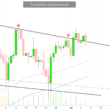The beginning of this year hasn’t been very favorable for electric-vehicle (EV) enthusiasts. Harsh weather conditions in Chicago left some unfortunate EV drivers stranded. Not only that, but Tesla has also reduced prices in China and Europe, while Ford Motor is scaling back production of its F-150 Lightning electric truck in the U.S.
Declining Stock Performance
Unfortunately, the woes of EV producers extend to the stock market as well. In January alone, the stock prices of EV producers have seen a significant decline, and Friday’s trading session is no exception.
During midday Friday trading, Tesla stock fell by 1.6%, reaching $208.51. This brings the total decline in shares to 16% so far this month. On the other hand, the S&P 500 and Nasdaq Composite experienced a slight increase of 0.5% and 0.6%, respectively.
Tesla’s Troubles
Tesla now finds itself on the brink of an ignominious record. If shares continue to fall on Friday, it will mark the 10th trading day of losses out of the first 12—an unfortunate distinction for Tesla, making it the worst start to any year in its history. To put it into perspective, similar declines occurred during the first 12 trading days of both 2015 and 2016.
However, despite Tesla’s struggles, other EV producers have fared even worse. Chinese EV makers NIO, XPeng, and Li Auto witnessed declines of 4.5%, 4.1%, and 3%, respectively, during Friday’s trading session. For the month of January, NIO experienced a staggering drop of 34%, while XPeng and Li Auto saw declines of 35% and 25% respectively.
Blame It on the Chinese EV Price Wars
The reasons behind Friday’s declines are not particularly new. Instead, they are an extension of a significant ongoing theme: Chinese EV price wars that have heavily impacted investor sentiment.
Even EV producers in the United States haven’t been immune to investors’ concerns. Rivian Automotive shares fell by 1.2% during Friday’s trading, resulting in a total decrease of 34% year-to-date. Similarly, Fisker shares saw a decline of 2.2%, despite receiving an upgrade from Sell to Hold on Thursday evening. As of midday trading on Monday, Fisker’s stock had dropped by approximately 55% since the beginning of the year.
Reasons for Weakness in Tesla Stock
Downgrades, production cuts from Ford, and disappointing delivery numbers from EV start-up VinFast Auto, along with controversial tweets by Tesla CEO Elon Musk asking for some $30 billion in more Tesla stock have all contributed to the recent weakness in Tesla’s stock. There are several factors that have led to investors selling their shares.
Earnings Report
Tesla is scheduled to release its fourth-quarter earnings on Wednesday, Jan. 24 after the market closes. Analysts on Wall Street expect earnings per share of 73 cents. A positive earnings report, coupled with any commentary from Musk about stable pricing or improving profit margins, could significantly boost investor sentiment.
Stock Market Technicals
Market technicians will analyze stock charts to gain insights into the potential future movement of a stock in the short or medium term. Currently, Tesla stock is considered oversold, indicating that it has experienced a significant decline in a short period of time. Oversold stocks typically bounce back as all the negative news is already priced into the shares. This provides some hope for Tesla bulls. Notably, Katie Stockton, the founder of Fairlead Strategies, identifies a potential support level for Tesla stock at $208, which is close to the trading price on Friday.
While it is challenging to predict when or why the selling will stop, considering these factors could provide some guidance. Earnings performance and stock market technicals can offer valuable insights for investors.






